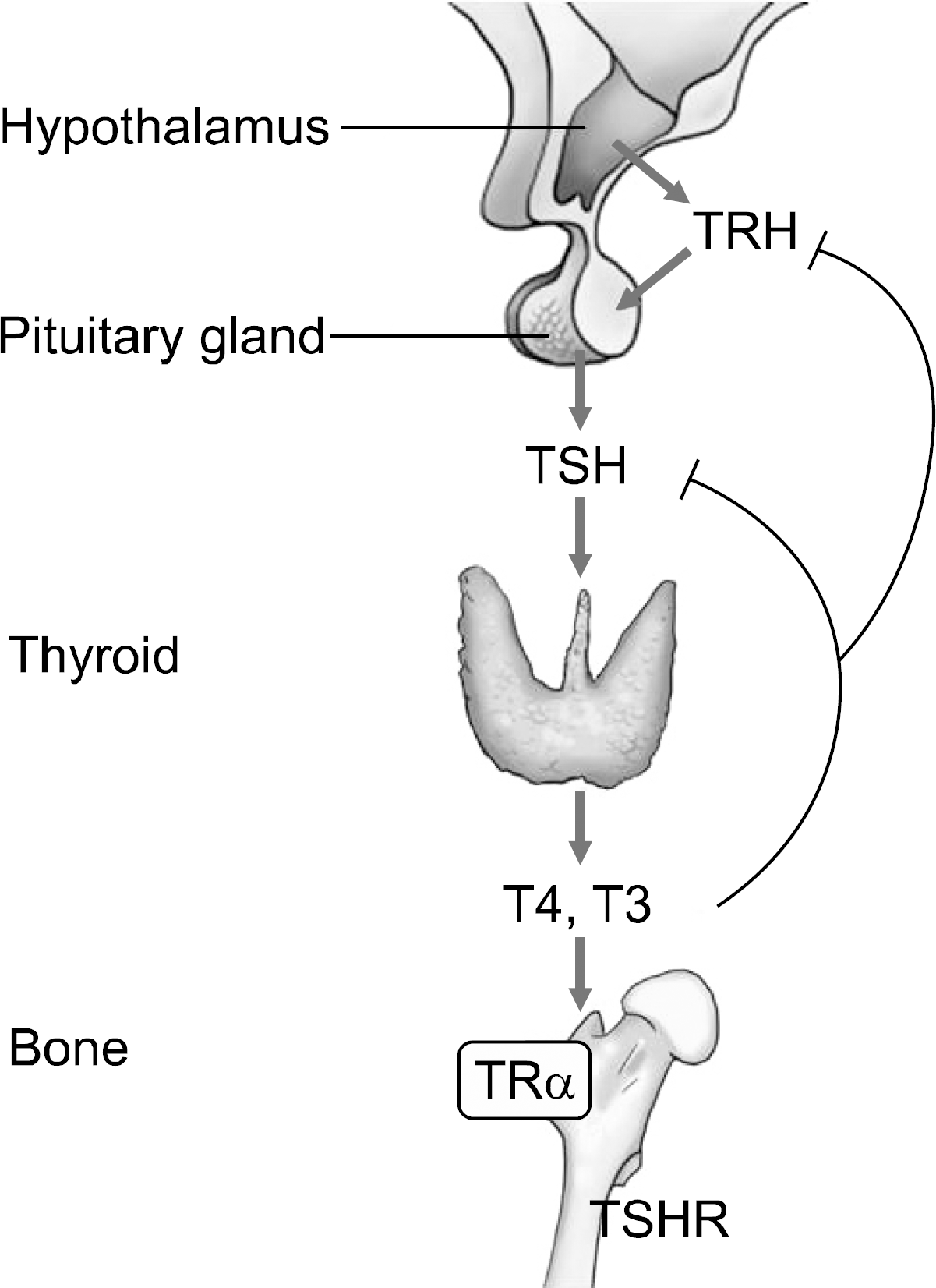Abstract
Bone is a dynamic tissue undergoing life-long remodeling, a process of bone resorption by osteoclast and bone formation by osteoblast, regulated by diverse hormones including estrogen. Recently, several pituitary hormones have been identified as a modulator of this process. Here, we reviewed the role of thyroid stimulating hormone signaling per se in bone metabolism.
Go to : 
References
1. Weitzmann MN, Pacifici R. Estrogen deficiency and bone loss: an inflammatory tale. J Clin Invest. 2006; 116(5):1186–94.

2. Menagh PJ, Turner RT, Jump DB, Wong CP, Lowry MB, Yakar S, et al. Growth hormone regulates the balance between bone formation and bone marrow adiposity. J Bone Miner Res. 2010; 25(4):757–68.

3. Ebeling PR. What is the missing hormonal factor controlling menopausal bone resorption? J Clin Endocrinol Metab. 2010; 95(11):4864–6.

4. Bauer DC, Ettinger B, Nevitt MC, Stone KL, Study of Osteoporotic Fractures Research Group. Risk for fracture in women with low serum levels of thyroid-stimulating hormone. Ann Intern Med. 2001; 134(7):561–8.
5. Seriwatanachai D, Thongchote K, Charoenphandhu N, Pandaranandaka J, Tudpor K, Teerapornpuntakit J, et al. Prolactin directly enhances bone turnover by raising osteoblast-expressed receptor activator of nuclear factor kappaB ligand/osteoprotegerin ratio. Bone. 2008; 42(3):535–46.
6. Tamma R, Colaianni G, Zhu LL, DiBenedetto A, Greco G, Montemurro G, et al. Oxytocin is an anabolic bone hormone. Proc Natl Acad Sci U S A. 2009; 106(17):7149–54.

7. Rivkees SA, Bode HH, Crawford JD. Long-term growth in juvenile acquired hypothyroidism: the failure to achieve normal adult stature. N Engl J Med. 1988; 318(10):599–602.
8. Abel ED, Ahima RS, Boers ME, Elmquist JK, Wondisford FE. Critical role for thyroid hormone receptor beta2 in the regulation of paraventricular thyrotropin-releasing hormone neurons. J Clin Invest. 2001; 107(8):1017–23.
9. Harvey CB, O'Shea PJ, Scott AJ, Robson H, Siebler T, Shalet SM, et al. Molecular mechanisms of thyroid hormone effects on bone growth and function. Mol Genet Metab. 2002; 75(1):17–30.

10. Abe E, Marians RC, Yu W, Wu XB, Ando T, Li Y, et al. TSH is a negative regulator of skeletal remodeling. Cell. 2003; 115(2):151–62.

11. Kim CH, Kim HK, Shong YK, Lee KU, Kim GS. Thyroid hormone stimulates basal and interleukin (IL)-1-induced IL-6 production in human bone marrow stromal cells: a possible mediator of thyroid hormone-induced bone loss. J Endocrinol. 1999; 160(1):97–102.

12. Bassett JH, Nordstrom K, Boyde A, Howell PG, Kelly S, Vennstrom B, et al. Thyroid status during skeletal development determines adult bone structure and mineralization. Mol Endocrinol. 2007; 21(8):1893–904.

13. Ishikawa Y, Genge BR, Wuthier RE, Wu LN. Thyroid hormone inhibits growth and stimulates terminal differentiation of epiphyseal growth plate chondrocytes. J Bone Miner Res. 1998; 13(9):1398–411.

14. Bassett JH, Williams AJ, Murphy E, Boyde A, Howell PG, Swinhoe R, et al. A lack of thyroid hormones rather than excess thyrotropin causes abnormal skeletal development in hypothyroidism. Mol Endocrinol. 2008; 22(2):501–12.

15. Morris MS. The association between serum thyroid-stimulating hormone in its reference range and bone status in postmenopausal American women. Bone. 2007; 40(4):1128–34.

16. Vestergaard P, Mosekilde L. Hyperthyroidism, bone mineral, and fracture risk–a metaanalysis. Thyroid. 2003; 13(6):585–93.

17. Weiss RE, Refetoff S. Effect of thyroid hormone on growth. Lessons from the syndrome of resistance to thyroid hormone. Endocrinol Metab Clin North Am. 1996; 25(3):719–30.
18. Weiss RE, Refetoff S. Treatment of resistance to thyroid hormone–primum non nocere. J Clin Endocrinol Metab. 1999; 84(2):401–4.

19. Papadimitriou A, Papadimitriou DT, Papadopoulou A, Nicolaidou P, Fretzayas A. Low TSH levels are not associated with osteoporosis in childhood. Eur J Endocrinol. 2007; 157(2):221–3.

21. Zaidi M, Sun L, Davies TF, Abe E. Low TSH triggers bone loss: fact or fiction? Thyroid. 2006; 16(11):1075–6.

22. Sun L, Vukicevic S, Baliram R, Yang G, Sendak R, McPherson J, et al. Intermittent recombinant TSH injections prevent ovariectomy-induced bone loss. Proc Natl Acad Sci U S A. 2008; 105(11):4289–94.

23. Hase H, Ando T, Eldeiry L, Brebene A, Peng Y, Liu L, et al. TNFalpha mediates the skeletal effects of thyroid-stimulating hormone. Proc Natl Acad Sci U S A. 2006; 103(34):12849–54.
24. Mazziotti G, Sorvillo F, Piscopo M, Cioffi M, Pilla P, Biondi B, et al. Recombinant human TSH modulates in vivo C-telopeptides of type-1 collagen and bone alkaline phosphatase, but not osteoprotegerin production in postmenopausal women monitored for differentiated thyroid carcinoma. J Bone Miner Res. 2005; 20(3):480–6.

25. Martini G, Gennari L, De Paola V, Pilli T, Salvadori S, Merlotti D, et al. The effects of recombinant TSH on bone turnover markers and serum osteoprotegerin and RANKL levels. Thyroid. 2008; 18(4):455–60.

Go to : 
 | Fig. 1.Hypothalamus-pituitary-thyroid-bone axis. The hypo-thalamic neurons secrete thyrotropin releasing hormone (TRH) is secreted by hypothalamic neurons and carried down to the pituitary gland where it releases thyroid stimulating hormone (TSH). TSH reaches thyroid glands and stimulates the productions of thyroxin (T4) and triiodothyronine (T3) by binding to TSH receptor (TSHR). T3 exerts its actions on bone mainly through thyroid hormone receptor α (TRα). TSH can directly act on bone by binding to TSHR. Increased levels of circulating T3 can get negative feedback loop by inhibiting TRH and TSH releases. |
Table 1.
Bone phenotypes in dissociation of reciprocal relationship between thyroid hormone and TSH




 PDF
PDF ePub
ePub Citation
Citation Print
Print


 XML Download
XML Download